ASUS K53E: Testing Dual-Core Sandy Bridge
by Jarred Walton on April 8, 2011 1:00 AM EST- Posted in
- Laptops
- Intel
- Sandy Bridge
- Asus
Sandy Bridge Gaming Performance, One More Time
After the 3DMark results, and considering our previous look at SNB’s GPU performance, there’s not much new to say here. We’re still working on a full roundup of gaming performance and compatibility testing with Sandy Bridge, similar to what we did with the AMD E-350. Our standard suite of laptop gaming tests all ran without any apparent compatibility problems, but given this list hasn’t changed much Intel has had ample time to make sure these titles work. We’ve run the Low and Medium performance tests, with a selection of competing laptops in the charts below.
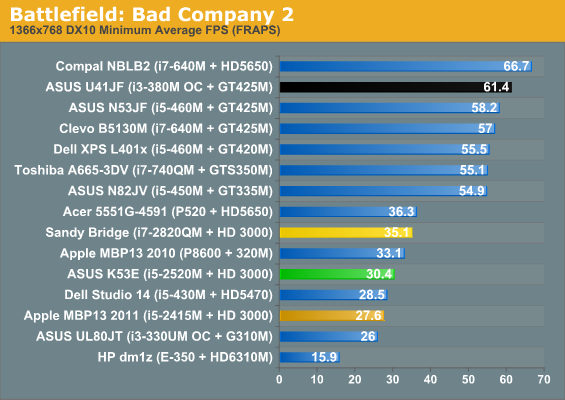
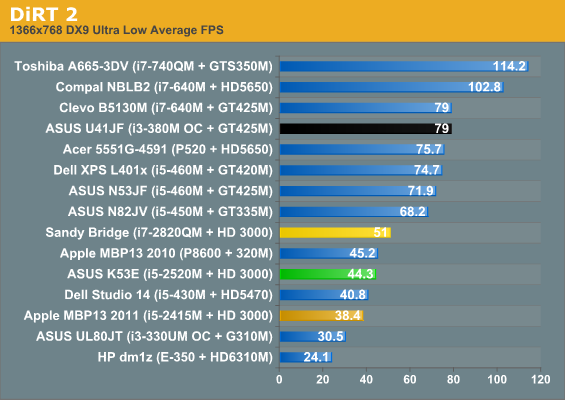
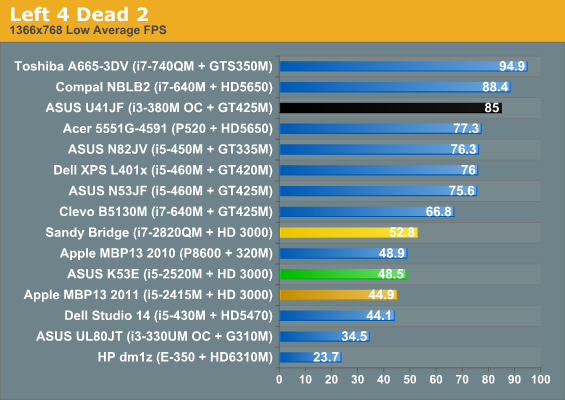
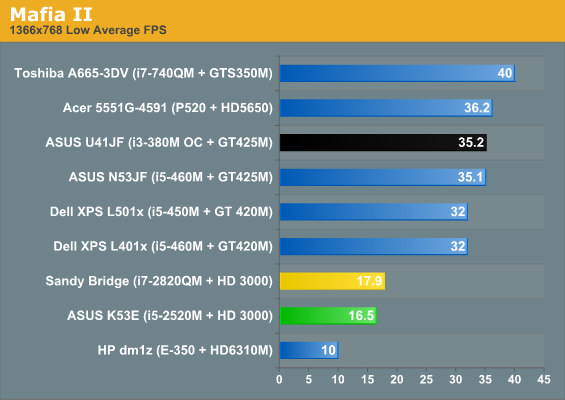
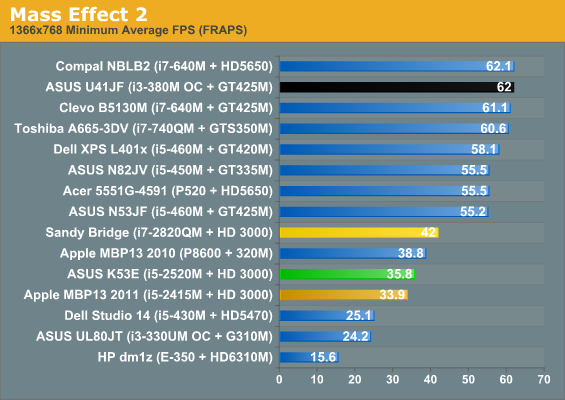
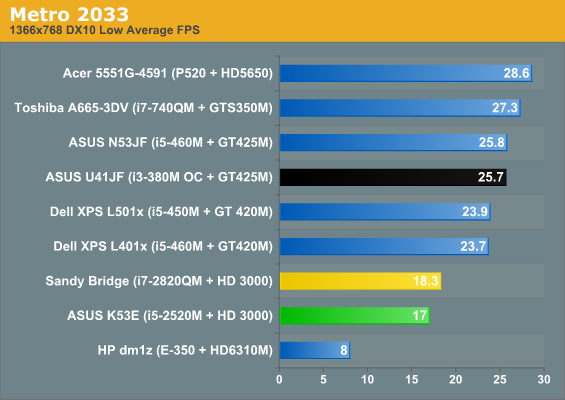
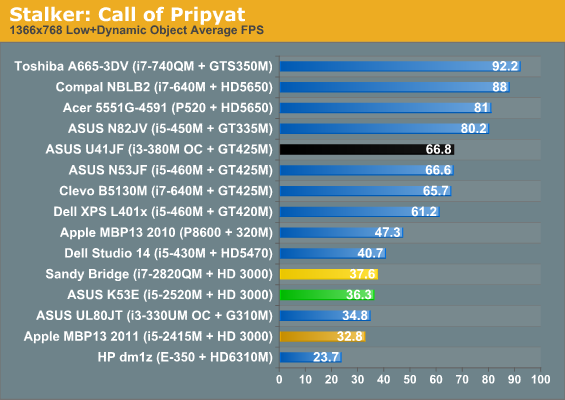
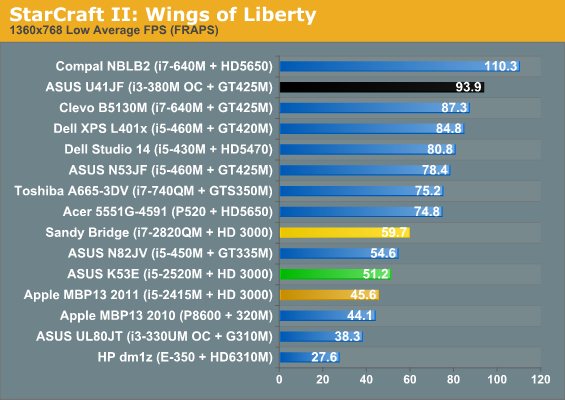
As we noted in the ASUS U41JF review, Intel’s relative standings in graphics are better with 3DMark than with actual games, particularly when we look at midrange GPUs like the GT 425M and HD 5650. Where the U41JF leads the K53E by 53% in the four 3DMark tests, in our eight actual games at low detail that increases to an 82% advantage. The K53E still leads the MBP13 2011 by 10%, and the i7-2820QM in turn leads the K53E by 12%—those results are the same as 3DMark, but then we’re dealing with the same IGP in all those cases. In terms of actual performance, the K53E breaks the 30FPS mark in six of the eight titles—Mafia II and Metro 2033 being the standard exceptions, but then those often fail to break 30FPS even on discrete GPUs.
What about the AMD E-350 comparison? As we just finished discussing, 3DMark shows the K53E coming in 125% faster than the E-350, though as we’ve noted in the past 3DMark can either skew things too much or too little towards CPU performance. Move over to our suite of games and the K53E still posts much higher scores than the E-350, but now the margin of victory is 88%. That’s still nearly twice the performance, and for a complete laptop you’re looking at around $725 versus $500 for similar components elsewhere. 45% more money for 88% faster graphics and 300% faster CPU performance isn’t a bad deal; what you don’t get with Sandy Bridge at that price is 8+ hours of battery life in an 11.6”-screen chassis.
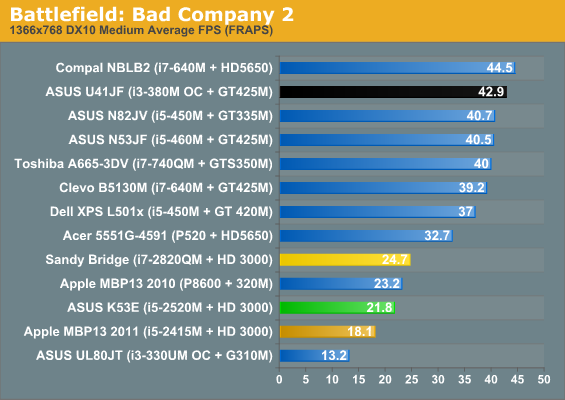


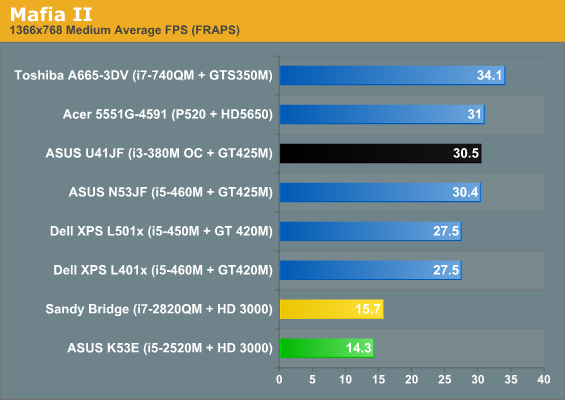

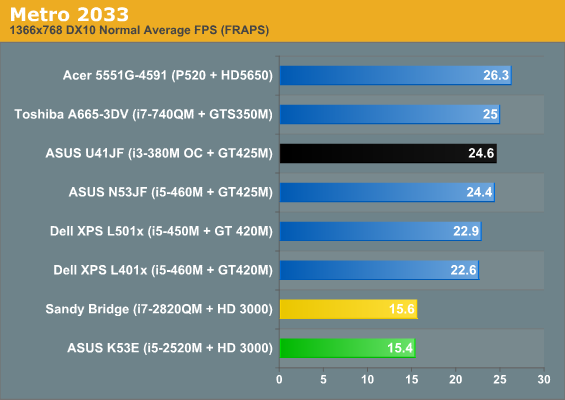
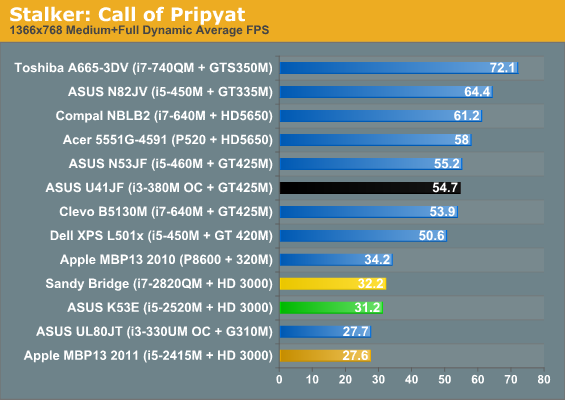
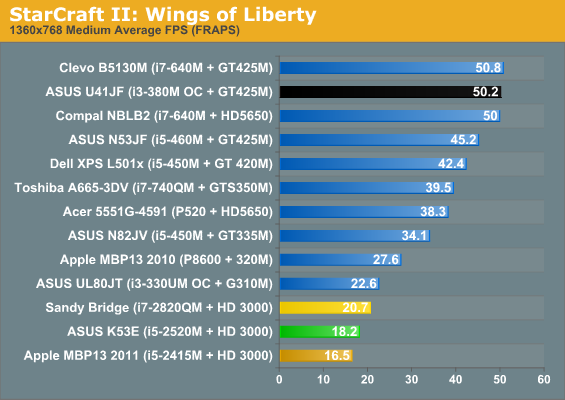
At medium detail settings, HD 3000 performance drops relative to the discrete GPUs. The K53E manages to hit 30FPS or higher in exactly one game this time: STALKER. It’s still 11% faster than the MBP13 2011, and the 2820QM is 14% faster than the K53E. Interesting to note is that the MBP13 2010 is also 15% faster than the K53, putting the GeForce 320M on the same level as the HD 3000 with quad-core CPU. By far the more pertinent piece of information is just how badly the U41JF trounces the K53E: Arrandale with a midrange dGPU comes out nearly 100% faster on average at our “Medium” settings, and it breaks 30FPS in every game in the list except Metro 2033.
For people looking to get an all-around laptop that can play games and provide adequate performance for general use, discrete GPUs are still required. Even then, midrange mobile GPUs are going to struggle with a lot of titles unless you turn down the detail settings and run at moderate (e.g. 720p) resolutions. On the other hand, if you’re not serious about gaming and graphics, Sandy Bridge’s IGP is very likely to satisfy the vast majority of users. Thankfully, it also manages to raise the bar relative to previous IGPs, with roughly double the performance of Arrandale’s HD Graphics and AMD’s HD 4250.
Rounding out the graphics discussion, other areas where the GPU helps also performed well. Viewing HD 1080p YouTube videos worked without any issues I could detect, thanks at least in part to the latest release of Adobe’s Flash player. Casual browser games like Bejeweled Blitz also worked fine, which isn’t something I could say on Arrandale where there was always a slightly perceptible delay—and that’s also a complaint I had with Brazos, which didn’t do well with Bejeweled Blitz. One interesting piece of information, however, is that the K53E really did poorly in Civilization V testing (not shown here, but you can see the scores in Mobile Bench), but whether that’s a driver problem or something else I can’t say.
Overall, gaming and graphics isn’t an absolute victory for Intel’s latest IGP, but it’s good enough for a large percentage of users. In the next month or so, we’ll see AMD’s counter to SNB with their second Fusion APU, Llano. That should provide at least double the GPU performance of Brazos, and even the aging K10.5 CPU core is a huge step up in performance from Bobcat. The combination should put Llano well ahead of HD 3000 in gaming, but whether it will be 50% faster or 100% faster we can't say for certain.
With a 32nm process technology and better use of power gating, Llano is going to be an interesting alternative, especially if the total system cost is similar to the $500 to $650 we’re seeing on current AMD notebooks. Sandy Bridge is unlikely to be touched for CPU computations by any of AMD’s mobile CPUs for the remainder of 2011, but with up to 400 Stream Processors Llano should come relatively close to the HD 6500 (HD 5600) series GPU performance. Put another way, while Intel’s HD 3000 is about twice the performance of Brazos’ IGP, Llano could easily double HD 3000. It’s a welcome change from the 15 to 25% improvements in IGP performance we often saw in previous platforms.










78 Comments
View All Comments
duploxxx - Friday, April 8, 2011 - link
what a lousy comment:On the other side of the charts—literally—is AMD’s E-350. We know it’s not meant to compete with Sandy Bridge (or even Arrandale or Core 2 Duo), but keep in mind that the cheapest price for such a laptop is going to be around $450. On average, the i5-2520M lays the smack down hard and ends up roughly four times faster than an E-350. Ah, but the E-350 has a much better IGP, right?
you could have also put some higher rated atom's here,Tthey all would have performed even worse for the same price. Its OEM who are pushing this price higher of the Brazos,
Watch the HD3000 scores and how they will be demolished by the LIano A8 series within a month the acer with P520 provides already a good idea about that besides the fact that it will have 4 cores at a much higher turbo frequency. The only thing that will be left is the higher single and dual core turbo mode for intel,.Afterall the i5M is exactly what should be compared with AMD A8M series, not a brazos......
JarredWalton - Friday, April 8, 2011 - link
Exactly, which is why I mention Llano oh... about nine times in the article, and point out that it should double the Brazos IGP performance with a CPU that "is a huge step up in performance from Bobcat." As for Atom: "There’s little (well, nothing really) to recommend an Atom netbook over a Brazos alternative at the $300 to $350 price bracket." Elsewhere I make fun of netbooks (Atom) for being, "slow, often poorly built, slow, too small for many to use comfortably, and above all really slow."The point with the SNB vs. E-350 comparison is that lots of people rip on Intel's graphics as being unfit for just about anything. The reality is that if we take the same mindset, Bobcat is just as bad because the CPU is such a massive bottleneck that it can only muster average graphics performance that's slightly faster than Arrandale. In reality, without the CPU bottleneck (or RAM bandwidth bottleneck) I suspect HD 6310M would be slightly faster than HD 3000. But when SNB offers about twice the graphics performance and four times the CPU performance and 80% of the battery life, yeah, those are items worth mentioning. It's also about 50% more expensive, of course.
A balanced approach is the best for laptops, and that's my complaint with a lot of systems. Sandy Bridge is at least fast enough on the GPU side that the only people who won't be happy are serious gamers--casual gamers can get by. Brazos is also somewhat balanced, but the Bobcat core isn't enough even if it beat Atom--it's less than half the CPU performance of an Athlon II P320 for instance, and you will notice that when installing programs, loading applications, booting Windows, etc. Right now, Brazos needs more CPU, Danube needs more battery life and less power/heat and a better IGP, and gamers need a discrete GPU. Llano could easily take care of all three items.
crazyape995 - Friday, April 8, 2011 - link
I think the point duploxxx might be trying to make is that you intentionally compared Sandy Bridge against the E-350 to make it look bad.I understand the comments about AMD graphics being better than Intel's, but those were directed specifically at the Atom platform.
AMD's E-350 destroys anything Intel's Atom platform can do, even with Nvidia's help. But what sets me off is how you don't hesitate to put it against Intel's flagship processors, but nowhere do I see Atom's results in the benchmarks.
The chart looks like it was devised specifically to make the E-350 look like the worst chip available. And no amount of explainations/disclaimers change that.
JarredWalton - Friday, April 8, 2011 - link
Fact: There are $600+ E-350 laptops available. Regardless of whether or not they should exist, they do exist, and as such it's a fair comparison. I didn't include Atom because it's not even remotely in contention -- and if I had C-50 results I wouldn't include those either. If people don't understand that we selected 12-15 laptops for the charts out of our catalog of over 80+ reviews, I'm not going to apologize. Use Mobile Bench and make your own comparisons.The conclusion talks a lot about the strengths of Brazos and AMD, but some people have a history of being strong AMD advocates in our comments. Every time I/we suggest that AMD might not be the best choice, they have to post a rant about how we're paid off or blind/stupid/[insert pejorative]. Read our Brazos reviews and you'll see we focused a lot of good attention on the platform, though we didn't hesitate to call out the weaknesses.
Simply put, E-350 is not good for current games, and it's not particularly fast in general applications. It's fine for multimedia and basic office work, it gets good battery life, and it doesn't cost a lot. If that's what you want, it's a great solution. Personally, there are too many things I like to do that are sluggish on E-350 (i.e. casual browser games like Bejeweled Blitz come to mind).
derricker - Friday, April 8, 2011 - link
"The conclusion talks a lot about the strengths of Brazos and AMD, but some people have a history of being strong AMD advocates in our comments. Every time I/we suggest that AMD might not be the best choice, they have to post a rant about how we're paid off or blind/stupid/[insert pejorative]. "Has it occurred that it's too obvious in front of everybody's eyes and that you particularly are not doing that great of a job in trying to deny the blatant bias in favor of intel??
The rudeness of your replies comes as a surprise for me here at anand, seeing a heavily biased articled in favor of those who pay the bills, that's yesterday news.
TypeS - Saturday, April 9, 2011 - link
There's no rudeness in his post and it's quite clear the bias towards AMD that you and the other two posters who are attacking Jarred have. Seems Jarred has a point made about AMD fanboys and comments.Learn to be more observant and aware before you make such biased and unfounded accusations. It's OEMs like Sony who are placing Brazos into a regular notebook form factor and pricing it within striking distance of the ASUS notebook. The point that should come across is that if you start looking at some unbalanced (perhaps even overpriced) E-350 options out there, its worth an extra $100 for overall better performance.
There's no Intel bias here. And AMD fanboys need to face reality, AMD has a brief moment in the spotlight with K8 but Intel has been 1 or 2 steps ahead ever since Conroe. Even when comparing appropriate alternatives (based on SKUs), Intel wins.
But you'll find lots of articles where the writers here Anandtech praise AMD, maybe not as much in the CPU market but quite often a lot in the GPU market where they immensely improved and given nVidia a lot of smackdowns that no one expected woujld come.
So take your defensive AMD fanboyism out the door and learn to be more observant and open-minded.
kevlno3 - Saturday, July 30, 2011 - link
To be reality is , don't trust the benchmark. it's not going to benefit you anything. It's only let Intel earn 86% in the market.i trust the benchmark , review . now i suffer in Dell N4110. it's doesn't perform well.
I would said , value of money is most important. when u buy the new notebook , you can save RM3-400 ,why you need to buy Intel? it's wouldn't last you up to 3 years. your model will just out of date in another 9months.
I will go back to AMD after i can let go this Dell N4110.
To be frank to whole world ,80% PC user wouldn't notice the speed different in his work space. you can't notice the speed different in 80% time you turn on your computer , you wouldn't notice the different when u doing autoCAD , sending email , log in facebook . but only thing u notice is when u loading the program. (just because this reason we let Intel earn 80% in market.)
erple2 - Sunday, April 10, 2011 - link
Do you also believe that the Moon Landings were a staged hoax because the Astronauts gave up swearing to things that they were actually at the moon?It's not obvious in my eyes at all. If you want to be rude, go ahead. I think that Jarred (and most of Anandtech) has been quite unbiased towards either camp. Just because your team doesn't win out on every (reasonable) comparison, doesn't imply any kind of bias at all.
ET - Saturday, April 9, 2011 - link
Jarred, I agree with your reasoning for including the E-350. Some people are blinded by AMD fanboyism, it seems. I have a preference for AMD, but I think your comments are right on the money. I bought a Thinkpad X120e because I think that AMD did a great job reinvigorating the small form factor. At 15.6" the E-350 has more competition and the premium for Intel based solutions is lower, so I think it's a good idea to give buyers an idea of how it compares in this form factor.That said, I think it would have been interesting to see how the i3-2310M version of this laptop compares.
kevlno3 - Saturday, July 30, 2011 - link
i would tell u , u wouldn't notice you are using E350 or core i3 2310. i totally dislike my Dell N4110 core i3 2310 . because the battery life is just 3hours .(normal price is RM1899 from Dell website , i buy promotion price from dealer , RM1.6k with HD6630 , 4GB , 500GB 7200rpm) E350 is about 6 hours & price is just RM1099. of course i wouldnt go for that model , because i need to play game , i need some model at least with HD6470.in fact currently Llano notebook is going crazy . pair with 6650 but only help the benchmark about 10% & the price is nearly to the core i5 model. core i5 2410 + GT540 RM2299. Llano sell RM 1800.
Dell i5 2410 + HD6470 is selling RM1899.
i would agree the price if AMD Llano w.o the HD6650 & the price is selling RM1.4k with 5-6 hours battery life
USD 1 = RM3
in fact i using C50 to complete all my office work with 8hours battery life . but i think i can't do it with Atom. if not why most of my friend sell it after 2 week?